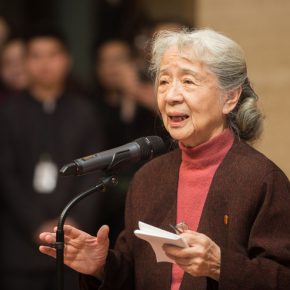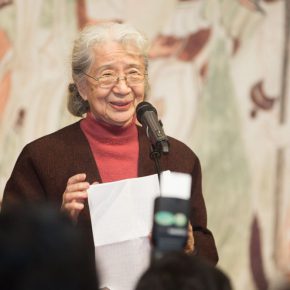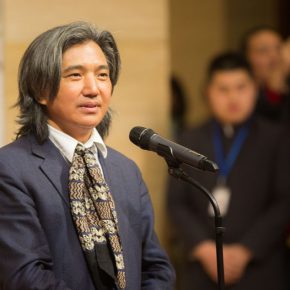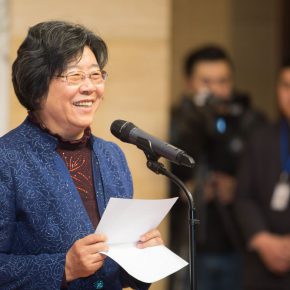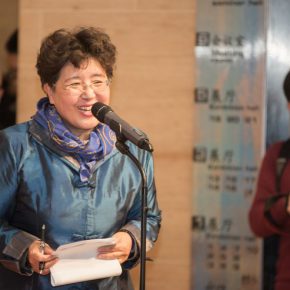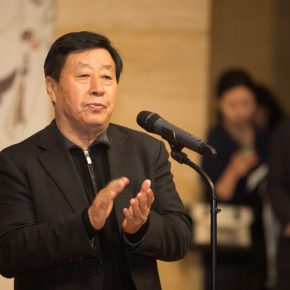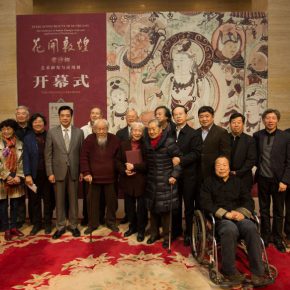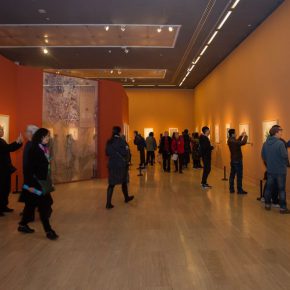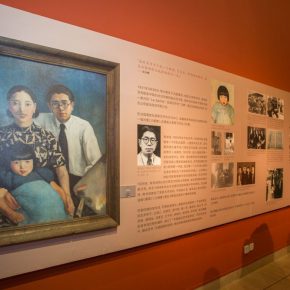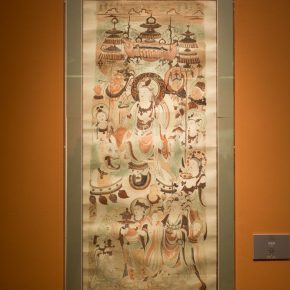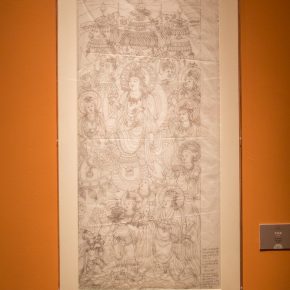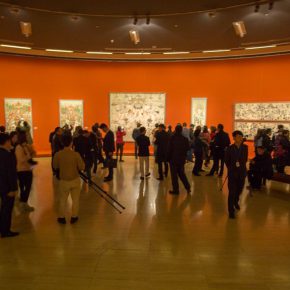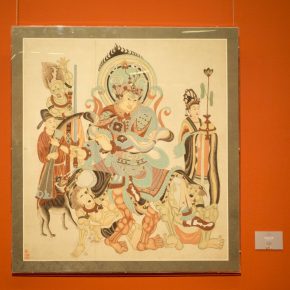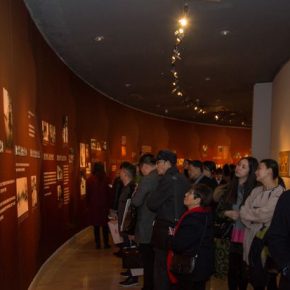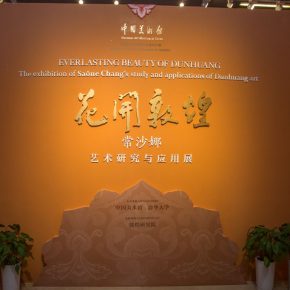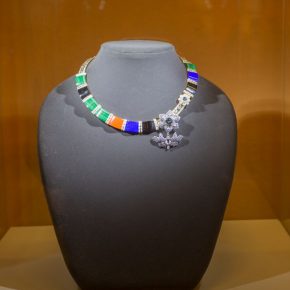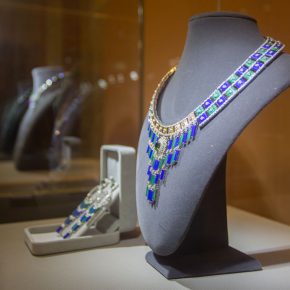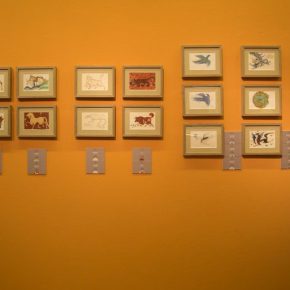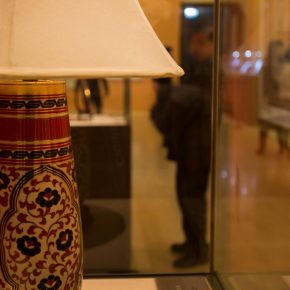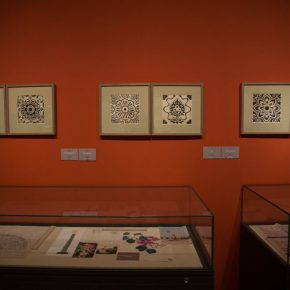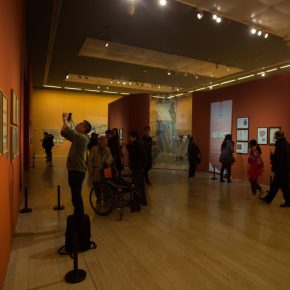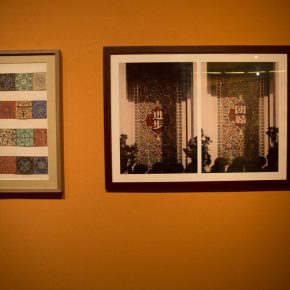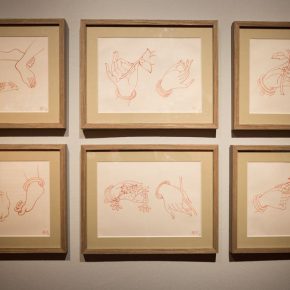
If we say that Chang Shuhong saw the lofty tradition of art from Dunhuang, Zhang Daqian harvested from picturesque scene of the blue and green landscape painting from Dunhuang, Dong Xiwen was enlightened by the charm of national painting, Saone Chang found the elegance and dignity, the rich and varied decoration world in the classical art.
– Wu Weishan
On the afternoon of March 8, 2017, hosted by the National Art Museum of China and Tsinghua University, “Everlasting Beauty of Dunhuang: The exhibition of Saone Chang’s Study and Applications of Dunhuang Art” was held at the National Art Museum of China, the opening ceremony was presided over by An Yuanyuan, Deputy Director of the National Art Museum of China, Wu Weishan, Director of the National Art Museum of China, Han Jingyang, former Secretary of the Party Committee of Tsinghua University, Liu Dawei, Chairman of China Artists Association and artist Saone Chang respectively delivered a speech. The opening ceremony attracted nearly a thousand people including honored guests Fan Di’an, President of the Central Academy of Fine Art, Lu Xiaobo, President of the Academy of Arts & Design, Tsinghua University, artist Pang Tao, Prof. Li Yanzu from Tsinghua University, Hou Liming, Director of the Institute of Fine Arts at Dunhuang Academy, and Liu Jude, Lin Lecheng, Zhang Fuye, Lv Pintian, Du Dakai and other leaders, experts, artists of cultural and artistic circles, as well as journalists.
Saone Chang is a famous art designer and educator, the daughter of Chang Shuhong who was the “Eudemon of Dunhuang”. She was born in Lyon, France and her parents were all artists studying aboard in France, and carrying her father’s behest, she dedicated her life to the protection, research and education of Dunhuang art. As the NAMOC Donation and Collection Series of Exhibition, the exhibition takes three key words “Keep Watch”, “Purify”, and “Inherit” to run through the artistic experience in different periods of Saone Chang. It is through a variety of works of art, such as the copying of murals, the floral drawing, and the application design, etc., cooperated by detailed documents, trying to show the panorama of the art career of Saone Chang, showcasing her colorful art life.
Part 1 of the exhibition “Keep Watch”, mainly presents that Saone Chang has a profound root in Dunhuang under the guidance of her father Chang Shuhong. It is divided into three units, in the first unit of “I Came from Paris” and unit 2 of “Rooted in Dunhuang”, it recalls the early years of the moving to Paris, Beijing, Kunming, Chongqing, Dunhuang together with her father Chang Shuhong by the way of illustrating, recording the profound friendship between Saone Chang and some important artists of the 20th century including Lv Sibai, Wang Linyi, Wang Henei in the special historical period. In the unit 3 of “Transmission of the Love of Dunhuang” mainly presents the facsimiles of mural paintings by Saone Chang when she lived in Dunhuang in the early years. From 1945 to 1948, she finished all facsimiles including the large-scale work of “The Sutra of Contemplation on Buddha Amitayu” when she was at the age of 14 going to the age of 17, but her works present great artistic talents. Saone Chang said, “It was the local conditions of Dunhuang that cultivated my honest personality; it was the art of Dunhuang that gave me the skills to learn traditional art.” This part presents more than 30 copies of works, which were the results of this special experience, and also an important artistic wealth of Chinese art development in the 20th century.
Part 2 of “Purify” mainly showcases Saone Chang’s research and development on Dunhuang’s art elements. It is divided into two units. Unit 1 of “Designed for the New China” showcases the major national architectural designs participated in by Saone Chang since the 1950s. Chang took Dunhuang’s patterns as blueprints to finish the architectural designs of the Great Hall of the People and the Culture Palace of Nationalities, while the works do not only embody the charm of Chinese classical art, but also showcase the new China’s tolerance, representing Chang’s refining and sublimation of the essence of traditional art. At the same time, Chang is one of earliest scholars who were engaged in the research and teaching of Dunhuang’s patterns, unit 2 of “Research of Dunhuang’s Patterns” features Chang’s research and finishing on Dunhuang’s patterns. Over the years, Chang is crazy about the art elements of Dunhuang’s murals, finishing all kinds of patterns, including the patterns of characters’ clothing, head wear and accessories; architectural canopy and tiles’ pattern; and the flowers and trees, beasts, etc. hidden in the dense mural paintings, and it has accumulated a large number of works of patterns after a systematical arranging. These works do not only interpret the refining and flourishing of the classical art with a variety of forms, but also re-examine the precious cultural heritage left by the ancestors from the perspectives of pattern and design.
Part 3 of “Inherit” mainly showcases the teaching and application of Chang in the teaching of patterns. It is divided into 2 units. Unit 1 of “One Flower is a World” presents the floral paintings by Chang. She said that, “I grasp two aspects in the teaching of pattern – the national tradition and the nature of life”. If the above show presents the “tradition of nation”, it mainly presents the “nature of life”. The floral works are gentle and pleasant, while revealing the healthy and strong of life, which is the true portrayal for the artist’s personality. Unit 2 of “Ancient Rhymeand New Style” showcases Chang’s design and application of Dunhuang art patterns. In the 1950s, influenced by Lin Huiyin, Chang entered the field of art and design. In 1956, Chang was transferred to the newly established Central Academy of Arts and Crafts, combining her familiar Dunhuang art and the knowledge of art design, and practiced it, creating the “national, scientific and popular” works of art and design.
At the opening ceremony, Saone Chang generously donated her 24 classical works to the National Art Museum of China for permanent collection. Dong Wei, Deputy Minister of the Ministry of Culture issued a “donation certificate” to Saone Chang. Wu Weishan, Director of the National Art Museum of China said that, “She is the model of our generation for her realm and vision, her mind and knowledge.”
The exhibition remains on view till March 19.
Text was edited by Lin Jiabin, Photo by Hu Sichen/CAFA ART INFO
Translated by Chen Peihua and edited by Sue/CAFA ART INFO


